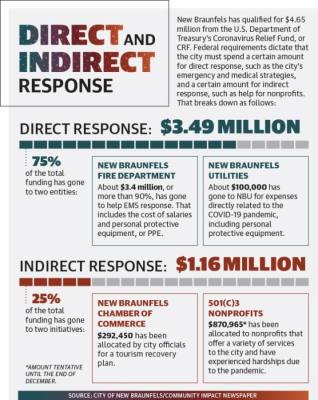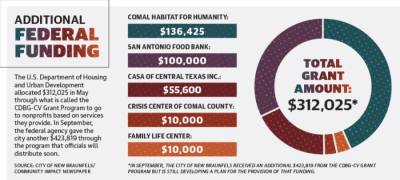Around early March, New Braunfels resident Bob Wolf knew that things were going to get dicey for his main source of income.
Prior to the COVID-19 pandemic, Wolf had been selling his custom, hand-crafted jewelry through his business, Bob Wolf Designs, at about 30 trade shows and fine arts festivals per year.
“We had one show in early spring, in the first week of March, and then after that we started getting cancellations because of COVID-19,” Wolf said. “We had the best calendar set up for this year. Our shows were booked, and in many cases our booth rents were paid, and then we started seeing the cancellations.”
Throughout the remainder of the year, Wolf estimated he lost about 90% of his normal bookings, and he said that translated to about a 90% loss of his anticipated 2020 revenue.
One of the factors that helped keep Wolf treading water and not losing the business, he said, was a $10,000 grant from the city of New Braunfels.
Bob Wolf Designs was one of more than 60 businesses to receive a grant from a $600,000 pot allocated through the city’s general fund budget this year.
However, local leaders acknowledge that when it comes to managing and constructing financial safety nets, the area’s small businesses comprise just one facet of a multilayered community ecosystem—all parts of which have needed help during the pandemic.
In order to ensure business owners, first responders, nonprofits and other members of the New Braunfels community continued to survive during an unprecedented fiscal bleed out, members of City Council, staff and volunteers are allocating about $6.6 million in federal and city funds.
“I so appreciate the city [helping businesses],” Wolf said. “It helps not only me, but it gets more money into circulation in our community.”
Helping small businesses
During the beginning of the pandemic, Jared Werner, New Braunfels chief financial officer, other city staff members and the economic development corporation, or EDC, helped free up about $600,000 for the COVID-19 Small Business Resource Grant.
The city sifted through more than 200 applicants, but with each recipient receiving about $10,000, the first round was narrowed to 67, with Bob Wolf Designs among them.
“With the help of the city, we’ve really ramped up and got a robust web store and put some effort into it,” Wolf said. “Prior to that ... we weren’t dependent on a web store for our business.”
Wolf said cultivating a web presence for his custom jewelry was just one of the initiatives the city grant allowed him to undertake.
The city and EDC also freed up about $6,000 to help five local businesses this year through the Downtown E-Commerce Assistance Grant. Werner said they are planning for another small-business grant allocation for fiscal year 2020-21—also amounting to roughly $600,000.
“I don’t know if the program the second time around is going to take the exact same form as it did on the first round,” Werner said. “The thought is that we need to revisit where those dollars need to be reinvested.”
Different paths for dispersal
New Braunfels has qualified for $4,653,660 of Coronavirus Relief Fund money to be divided into two parts.
The first consists of a direct expenditure of 75% of the funds, or $3.49 million, that has been used toward emergency medical response and some utility expenses through New Braunfels Utilities. The rest goes toward an indirect expenditure pot totaling 25%, or about $1.16 million.
Officials divided the indirect expenditure pot into two parts consisting of $292,450 for a tourism recovery plan coordinated by the New Braunfels Chamber of Commerce, and $870,965 to help local nonprofit organizations.
Given the fact that the city has already put $600,000 into private-sector investments and has another $600,000 planned for the upcoming fiscal year, Werner said planners thought it was appropriate to invest the federal dollars in nonprofit agencies that were not eligible for those monies. Council approved a grant program to help these agencies in October.
Beyond the money that will be given to nonprofits through the grant program, the city has also given out $312,025 through a federal grant from the U.S. Department of Housing and Urban Development called the Community Development Block Grant, or CDBG-CV Grant Program.
The lion’s share given to EMS
The remainder of the CRF funding for New Braunfels, roughly $3.5 million, has gone toward the direct response to COVID-19.
About $100,000 has gone to NBU, the local utility company, for expenses that include personal protective equipment and sanitation measures.
Werner said the city decided to allocate the remaining $3.4 million to its emergency management services response, which is a part of the New Braunfels Fire Department.
Both Werner and Mayor Rusty Brockman agreed it made the most sense to designate the city’s emergency medical services response for the remainder of the CRF funding.
“The reason we recommended EMS is because beginning in April, they had been operating assuming every single call is a COVID[-19] call until it could be confirmed that it was not. So, their operations have been substantially redirected or changed in that way,” Werner said.
Another reason the funding designation made sense—Patrick O’Connell, New Braunfels Fire Department chief, and his crew have been working directly with Comal County’s health office and medical director, Brockman said. They have been keeping up with personal protective equipment acquisitions, training staff and helping run mobile testing sites in order to act as the front line of the pandemic response.
For his part, O’Connell preferred to highlight the entire response to the pandemic from all facets of the city.
But as it pertains to why his EMS department received the federal dollars for the direct expenditure, he described a rapid transition by his staff from February to March of this year.
For about eight weeks O’Connell’s EMS department hired extra call screeners who would evaluate certain types of calls. If those calls were determined to be from a COVID-19-positive patient, his crew would decide if the patient needed to be taken to the hospital or was better off staying at home.
He said his crew was also instrumental in helping develop Comal County’s drive-thru COVID-19 testing facility and provided staffing for it two days a week since the spring.
The list of direct-response initiatives is lengthy, evidenced by the fact that O’Connell’s crew was also tapped by the Texas Department of Emergency Management to test all of the nursing homes in the city of New Braunfels—a process that consisted of testing more than 1,000 patients in a five-day period, he said.
“Then we had a rapid testing team that we would deploy within hours’ notice to go test at hot spots around our region, and we would still do that if requested,” he said.
Continuing to provide relief
Werner and Brockman said the city’s network of staff, volunteers and elected officials is continuing to respond to and plan for the pandemic and point to plans to invoke another round of business grants for the 2020-21 fiscal year.
Asked about recent news regarding promising vaccines showing higher than 90% efficacy that have emerged from pharmaceutical companies including Pfizer and Moderna, Brockman was reluctant to say how that would affect the city’s ongoing efforts.
The city still needs to protect its people and its businesses, and he said he believes it is imperative that the overall response not include speculation with regard to a potential end to the pandemic, especially since no one yet knows when that will happen.
“Speaking for myself and not representing council or staff, I don’t think that looking into the future for a vaccine lightens the burden that the businesses have seen,” Brockman said. “So, I think we want to continue to help, whether the vaccine is on the doorstep or whether it’s two, three, six months out.”








